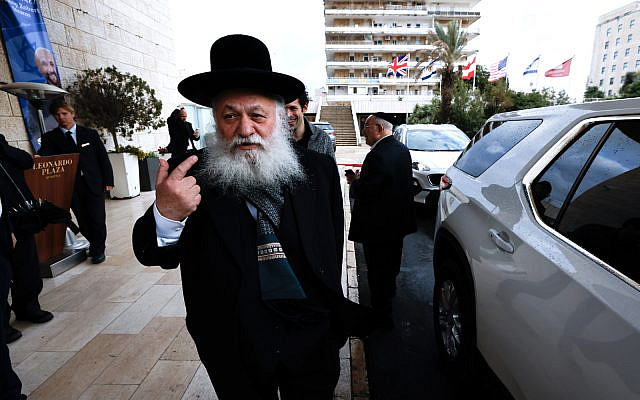In Bnei Brak I founded the shtetl-state
 |
| UTJ chairman Yitzchak Goldknopf |
The agreements currently being finalized for the formation of the new coalition government lay the foundations for the two-state solution: The State of Israel, and the State of the Shtetl. The Haredi enclave, which until now has been autonomous for the most part, has grown much larger and, in the wake of the recent elections, it is set to go one step further and become an autonomous state – a “statl,” if you will.
The ambassadors of the shtetl-state have gained positions of power and influence within the political system of the State of Israel, from which they can now rule their new state as they see fit. In addition to the ministerial positions that were specially created for the Haredi and national-religious publics, such as a new role that’s essentially the “Minister for Jerusalem, Heritage, and Religious Celebrations,” new positions are being created within the existing ministries for the shtetl’s ambassadors. For example, a Knesset member from the United Torah Judaism party is being appointed (in addition to his position as head of the Haredi Administration) as Deputy Minister for Public Transportation – specifically for the Haredi public.
The shtetl-state’s leaders are also worried by the same challenges that concern the leaders of the State of Israel. They can see that there are more and more Haredim who are unable to reach the ideal standard recommended by the Mishna to dedicate one’s life to the study of Torah and to be satisfied living in poverty and sorrow: “Bread and salt you will eat, measured water you will drink, on the ground you will sleep, a life of suffering you will live, and in the Torah you will labor.”
These leaders also want to ensure that their citizens have a reasonable standard of living. But it would seem that their preferred solution to this challenge is to change the rules of the game in the State of Israel.
Currently, to be accepted into a civil service position, candidates must have an academic degree and meet various criteria. The heads of the shtetl-state want to change these rules so that holding a Torah education will be considered equivalent to holding a bachelor’s degree. When added to the 2017 “Appropriate Representation Law,” which requires that Haredim be employed in government ministries in numbers proportional to the relative size of the Haredi population in Israel, this proposal offers an excellent solution to the economic problem: The State of Israel will simply employ the citizens of the shtetl-state en masse.
In parallel, the shtetl-state’s ambassadors are also demanding that women’s studies at Haredi post-secondary institutions (“seminars”) of paramedical subjects such as art therapy, be recognized as equivalent to academic degrees. It seems that an academic diploma and appropriate training are just nonsense, meant only for the secular population. For citizens of the shtetl, it is enough that the seminars teach students the proper religious mindset, bring in someone who has a diploma from somewhere, and lo and behold – they have a qualified, expert art therapist.
Including Haredim as employees in the state’s public systems is a highly necessary and welcome process, but there is a right way and a wrong way to go about it. Unfortunately, of the two roads that diverge in this wood, the one being chosen is that which leads us over the edge of a cliff. We will all pay the price for quick-fix solutions, and at a very high rate of interest over many years.
Not only will the price be paid by Haredi parents, who will unwittingly put their children in the care of what are essentially babysitters, who have had no proper training, but even more critical is the deathblow these solutions will deal to the trend toward Haredi integration that has gained momentum over the last decade and a half. And it may not be possible to recover from the damage this will do to efforts to integrate Haredim into Israeli society and its economy.
The future of the State of Israel hangs in the balance. All of us have the responsibility to ensure that the Meron disaster – the crowd crush during Lag BaOmer in which 45 men and boys were killed, a disaster that happened in the shtetl-state – is not repeated on a national scale for Israel as a whole.


